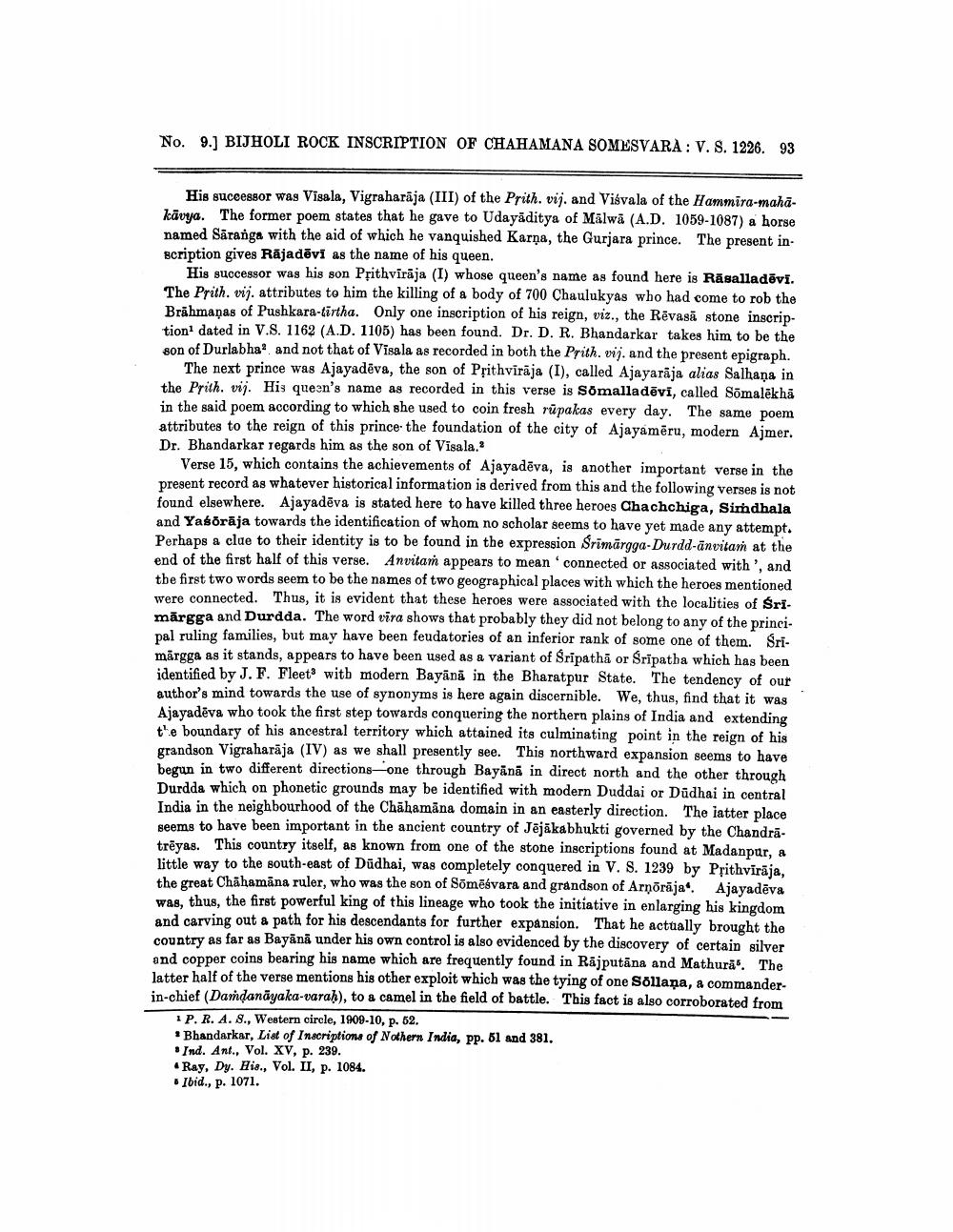________________
No. 9.] BIJHOLI ROCK INSCRIPTION OF CHAHAMANA SOMESVARA: V. S. 1226. 93
His suceessor was Visala, Vigraharāja (III) of the Prith. vij. and Visvala of the Hammira-mahakāvya. The former poem states that he gave to Udayāditya of Malwā (A.D. 1059-1087) a horse named Saranga with the aid of which he vanquished Karna, the Gurjara prince. The present in scription gives Rājadēvi as the name of his queen.
His successor was his son Přithvīrāja (I) whose queen's name as found here is Rāsalladēvi. The Prith. v. attributes to him the killing of a body of 700 Chaulukyas who had come to rob the Brāhmaṇas of Pushkara-tirtha. Only one inscription of his reign, viz., the Rēvasā stone inscription dated in V.S. 1162 (A.D. 1105) has been found. Dr. D. R. Bhandarkar takes him to be the son of Durlabha? and not that of Visala as recorded in both the Prith. vij. and the present epigraph.
The next prince was Ajayadēva, the son of Přithvirāja (I), called Ajayarāja alias Salhaņa in the Prith. vij. His queen's name as recorded in this verse is Somalladēvi, called Sömalēkhả in the said poem according to which she used to coin fresh rūpakas every day. The same poem attributes to the reign of this prince the foundation of the city of Ajayamēru, modern Ajmer. Dr. Bhandarkar regards him as the son of Visala."
Verse 15, which contains the achievements of Ajayadēva, is another important verse in the present record as whatever historical information is derived from this and the following verses is not found elsewhere. Ajayadēva is stated here to have killed three heroes Chachchiga, Simdhala and Yasörāja towards the identification of whom no scholar seems to have yet made any attempt. Perhaps a clue to their identity is to be found in the expression Srimārgga-Durdd-ānvitam at the end of the first half of this verse. Anvitam appears to mean connected or associated with ', and the first two words seem to be the names of two geographical places with which the heroes mentioned were connected. Thus, it is evident that these heroes were associated with the localities of Sri. mārgga and Durdda. The word vīra shows that probably they did not belong to any of the principal ruling families, but may have been feudatories of an inferior rank of some one of them. Srimärgga as it stands, appears to have been used as a variant of Sripathā or Sripatha which has been identified by J. F. Fleets with modern Bayānă in the Bharatpur State. The tendency of our author's mind towards the use of synonyms is here again discernible. We, thus, find that it was Ajayadēva who took the first step towards conquering the northern plains of India and extending the boundary of his ancestral territory which attained its culminating point in the reign of his grandson Vigraharāja (IV) as we shall presently see. This northward expansion seems to have begun in two different directions--one through Bayānā in direct north and the other through Durdda which on phonetic grounds may be identified with modern Duddai or Dūdhai in central India in the neighbourhood of the Chāhamāna domain in an easterly direction. The latter place seems to have been important in the ancient country of Jējākabhukti governed by the Chandratrēyas. This country itself, as known from one of the stone inscriptions found at Madanpur, a little way to the south-east of Dudhai, was completely conquered in V. S. 1239 by Prithviraja, the great Chahamāna ruler, who was the son of Sõmēśvara and grandson of Arņārāja. Ajayadēva was, thus, the first powerful king of this lineage who took the initiative in enlarging his kingdom and carving out a path for his descendants for further expansion. That he actually brought the country as far as Bayānā under his own control is also evidenced by the discovery of certain silver and copper coins bearing his name which are frequently found in Rajputāna and Mathura". The latter half of the verse mentions his other exploit which was the tying of one Sollana, a commanderin-chief (Damdanāyaka-varah), to a camel in the field of battle. This fact is also corroborated from
1 P. R. A. 8., Western circle, 1909-10, p. 52.
Bhandarkar, List of Inscriptions of Nothern India, pp. 61 and 381. . Ind. Ant., Vol. XV, p. 239. • Ray, Dy. His., Vol. II, p. 1084. Ibid., p. 1071.




